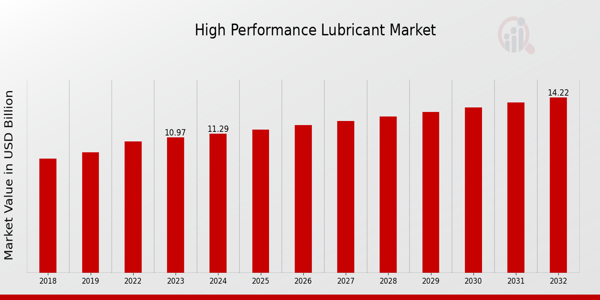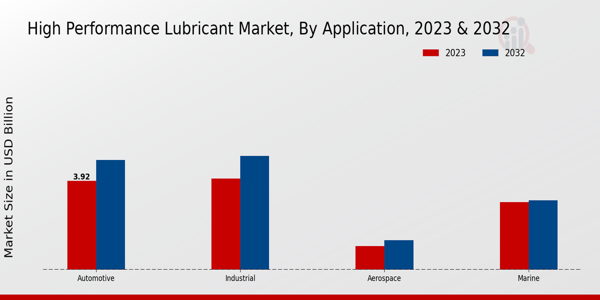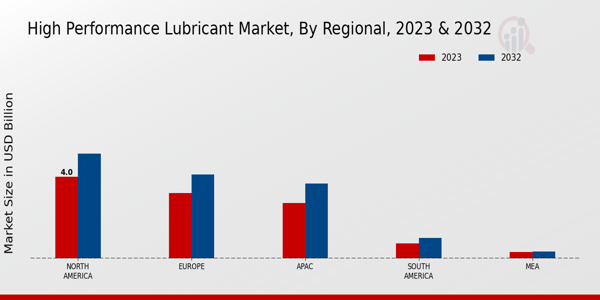Global High-Performance Lubricant Market Overview
The High Performance Lubricant Market Size was estimated at 11.62 (USD Billion) in 2024. High Performance Lubricant Industry is expected to grow from 11.96 (USD Billion) in 2025 to 15.50 (USD Billion) by 2034, at a CAGR (growth rate) is expected to be around 2.90% during the forecast period (2025 - 2034)
Key High-Performance Lubricant Market Trends Highlighted
The High-Performance Lubricant Market is expanding as a result of a number of fundamental driving forces. One of the prominent drivers is the growing rate of the demand for lubricant solutions which can minimize wear and increase efficiency in applications like automotive, industrial machines, and others. Also, there is a growing trend towards green products as consumers and industries prefer lubricants that have a lower adverse effect. Also, the rising interest in high performance lubricants can be attributed to formulation advances that enhance thermal stability and reduce friction. This change is also backed by the growing fuel-efficiency needs and the growing automotive industry.
There is scope in the market as there are untapped markets in developing countries which are seeing rapid growth in industries. With the increase in manufacturing and transportation activities, stimulation for the use of high performance lubricants catering to particular applications will also rise. Also, there is a shift towards electric vehicles, giving lubricant manufactures a brand new segment to tap into. Developments in material sciences are enabling the creation of synthetic lubricants with superior performance and longevity, allowing for market segmentation and monetization. They can also leverage the sustainable approach by creating and establishing green lubricant products in the market.
Recent trends in the market include a growing focus on research and development, as manufacturers strive to create more efficient, higher-performing lubricants. Digitalization is also making waves, with companies utilizing data analytics to enhance lubricant performance and predictive maintenance strategies. The use of advanced manufacturing technologies, such as 3D printing for lubricant components, is emerging as a method to innovate and reduce costs. Additionally, consumer awareness around the benefits of high performance lubricants is increasing, further driving demand, and shaping the market landscape.

Source: Primary Research, Secondary Research, MRFR Database and Analyst Review
High-Performance Lubricant Market Drivers
Technological Advancements in Lubricant Formulations
The High-Performance Lubricant Market Industry is experiencing significant growth due to continuous technological advancements in lubricant formulations. These advancements have led to the development of high-performance lubricants that offer superior lubrication properties, enhanced stability, and better performance under extreme conditions. Companies are investing heavily in research and development to create innovative products that can meet the demands of various industries, such as automotive, aerospace, manufacturing, and energy.Modern lubricants are designed to improve efficiency, reduce wear, and lower energy consumption, thus contributing to cost savings for various operations. Furthermore, the trend toward synthetic and bio-based lubricants is gaining momentum as manufacturers aim to create environmentally friendly products that do not compromise on performance. The introduction of additives and improvement of base oils have facilitated the creation of specialty lubricants that are tailored for specific applications, enhancing their marketability within the High-Performance Lubricant Market Industry.Additionally, stringent regulations regarding emissions and environmental standards are pushing companies toward greener solutions, further driving innovation in the formulation of high-performance lubricants. As industrial and automotive applications increasingly require enhanced performance metrics, the demand for advanced lubricant formulations is set to rise, thereby supporting the growth trajectory of the High-Performance Lubricant Market.
Rising Demand from Various End-User Industries
The High-Performance Lubricant Market Industry is significantly driven by the rising demand from various end-user industries. Sectors such as automotive, manufacturing, construction, and aerospace require lubricants that can function effectively in high-stress environments. The automotive industry, in particular, is a major consumer of high-performance lubricants due to the need for improved fuel efficiency and engine performance. As vehicles become more sophisticated and demanding in terms of technology, the requirement for specialized lubricants has become essential.Meanwhile, the manufacturing sector increasingly relies on high-performance lubricants for machinery and equipment to ensure optimal performance and minimize downtime. This surge in demand across diverse sectors is facilitating the growth of the High-Performance Lubricant Market.
Growing Awareness of Energy Efficiency
There is a growing awareness of energy efficiency in both industrial and automotive applications, which is positively impacting the High-Performance Lubricant Market Industry. Companies and consumers alike are looking for solutions that not only enhance performance but also contribute to energy savings. High-performance lubricants play a critical role in reducing friction and wear, which can lead to improved energy efficiency and lower overall operational costs.This trend is being driven by an increasing emphasis on sustainability and reduced environmental impact, pushing businesses to invest in high-quality lubricants that support energy conservation initiatives.
High-Performance Lubricant Market Segment Insights:
High-Performance Lubricant Market Application Insights
The High-Performance Lubricant Market showcases a diverse application landscape that significantly contributes to its overall value, currently estimated at 10.97 USD Billion in 2023. The market segmentation reveals a robust distribution across various applications, including Automotive, Industrial, Aerospace, and Marine. Each of these sectors plays a vital role in sustaining the demand for high-performance lubricants. The Automotive application segment holds a significant share with a valuation of 3.92 USD Billion in 2023, reflecting the ongoing need for vehicle efficiency and performance as consumers continuously seek advancements in engine technology and fuel economy. Following closely is the Industrial segment, valued at 4.01 USD Billion in the same year, highlighting its importance as industries prioritize operational efficiency and reduced downtime, taking advantage of high-performance lubricants to enhance machinery life and productivity.
The Aerospace segment, while smaller, at 1.05 USD Billion, underlines the specialized demand for high-performance lubricants in aviation, where safety, reliability, and adherence to strict regulations are paramount, making it a significant sector despite its lower market share. The Marine application, valued at 2.99 USD Billion, is also notable as it caters to commercial and leisure marine activities, emphasizing the need for lubricants that can withstand harsh marine environments and prevent corrosion. These market valuations collectively indicate the diversity and specific demands across applications in the High-Performance Lubricant Market, showcasing how different industries prioritize unique lubricant properties.
Growth drivers for these segments are rooted in the expansion of automotive production and increased industrial activities, alongside technological advancements that demand higher efficiency and performance from lubricants. Furthermore, with tightening environmental regulations, there is a growing trend towards sustainable and bio-based lubricants, further augmenting growth opportunities. However, challenges such as fluctuating raw material prices and the need for ongoing product innovation remain present. Understanding these dynamics is essential for stakeholders in the High-Performance Lubricant Market as they navigate through a competitive landscape characterized by evolving customer preferences and stringent regulatory requirements. The High-Performance Lubricant Market data reveals that while some segments dominate in terms of valuation, others offer significant opportunities for tailored product development and marketing strategies, ensuring all applications are aligned with current market trends and future demands.

Source: Primary Research, Secondary Research, MRFR Database and Analyst Review
High-Performance Lubricant Market Product Type Insights
The High-Performance Lubricant Market, valued at 10.97 USD Billion in 2023, is seeing notable growth driven by various product types including Engine Oils, Gear Oils, Greases, and Hydraulic Fluids. Engine Oils play a critical role in enhancing engine performance and fuel efficiency, making them a cornerstone in the automotive industry. Gear Oils are essential for reducing friction in machinery, thus prolonging lifespan and performance, while Greases are vital in minimizing wear and tear on moving parts, significantly impacting equipment reliability.Hydraulic Fluids, indispensable in hydraulic systems, ensure optimal performance across various sectors, highlighting their importance in industrial applications. The diverse applications of these product types underline their dominant presence in the High-Performance Lubricant Market. With the industry projected to grow steadily, market growth is being further supported by ongoing advancements in lubrication technology, increasing demand from automotive and industrial segments, and a shift towards sustainable lubricants, which present numerous opportunities for innovation and expansion within the market.
High-Performance Lubricant Market Base Oil Type Insights
The High-Performance Lubricant Market, valued at 10.97 USD Billion in 2023, shows a diverse segmentation based on Base Oil Type, encompassing Mineral Oil, Synthetic Oil, and Bio-based Oil. Among these, Mineral Oil remains a critical component, often favored for its reliability and cost-effectiveness in various applications. Synthetic Oil, known for its superior performance characteristics, plays an increasingly significant role, particularly in high-stress environments where temperature stability and engine efficiency are paramount. Bio-based Oil is gaining traction due to rising environmental awareness and regulations favoring sustainable products, positioning it as a major player in the market.The combination of these oils facilitates a wide range of applications across industries, contributing to the market's expected expansion. This growth is driven by trends such as technological advancements in lubricant formulations, the increasing demand from the automotive sector, and a shift toward environmentally sustainable solutions. However, challenges such as fluctuating crude oil prices and stringent regulations can impact market dynamics. Overall, the High-Performance Lubricant Market data reflects a robust opportunity landscape, with each oil type meeting specific industry needs, reinforcing their importance within the market's overall framework.
High-Performance Lubricant Market End Use Sector Insights
The High-Performance Lubricant Market, valued at approximately 10.97 USD Billion in 2023, is experiencing steady growth across various end-use sectors. The Oil Gas sector plays a crucial role, as high-performance lubricants are essential for ensuring efficient operations in exploration and production, where equipment reliability is paramount. Manufacturing is another significant sector, benefiting from advanced lubrication solutions that enhance machinery efficiency and reduce downtime. In the Transportation sector, high-performance lubricants are vital for improving fuel efficiency and extending engine life, driving substantial demand in both commercial and personal vehicle applications.The Construction sector also accounts for a massive share, as high-performance lubricants are necessary for heavy machinery and equipment that operate under demanding conditions. Overall, the High-Performance Lubricant Market data indicates a diverse and interconnected landscape, with each sector contributing uniquely to market dynamics and reflecting the evolving needs of industrial applications. The market growth is supported by a rise in industrial activities and advancements in lubricant technology, though it also faces challenges such as fluctuating raw material prices and environmental regulations.
High-Performance Lubricant Market Regional Insights
The High-Performance Lubricant Market is poised for steady growth, particularly across its various regional divisions. In 2023, North America holds the majority share with a valuation of 4.0 USD Billion, expected to rise to 5.12 USD Billion by 2032, driven by rising demand in automotive and industrial sectors. Europe follows closely, valued at 3.2 USD Billion in 2023 and projected to grow to 4.1 USD Billion by 2032, showcasing significant advancements in eco-friendly lubricants. The APAC region, representing emerging markets with evolving industrial needs, is valued at 2.7 USD Billion in 2023, with further growth anticipated to 3.65 USD Billion by 2032.South America, with a valuation of 0.75 USD Billion in 2023, and the MEA region, valued at 0.32 USD Billion, while smaller, reflect growing investment opportunities in the lubricant space, especially with the burgeoning energy sector. The High-Performance Lubricant Market data shows that these regions are adapting to trends like sustainability and technological innovations, which are pivotal for driving the market forward. Each area has its unique dynamics, contributing to the overall market growth in a collaborative manner.

Source: Primary Research, Secondary Research, MRFR Database and Analyst Review
High-Performance Lubricant Market Key Players and Competitive Insights:
The High-Performance Lubricant Market is characterized by a diverse range of players competing for market share, leveraging their technological advancements and extensive product portfolios to meet the demanding requirements of various industries. The competitive landscape is shaped by the ongoing innovations in formulation strategies aimed at producing lubricants that offer superior performance, including enhanced protection, longevity, and energy efficiency. Key drivers of competition include the growing awareness of sustainability and the increasing demand for products that can withstand extreme operating conditions. Companies are also focusing on strategic partnerships and geographical expansion to enhance their footprint in this rapidly evolving market. Additionally, the entrance of new participants and the continual advancement of established players will further intensify competition, pushing innovation and pricing strategies to new heights.Valvoline is a prominent player within the High-Performance Lubricant Market, known for its strong market presence and diversification of product offerings. The company has established itself as a trusted brand, emphasizing both quality and reliability in its lubricants, which cater to various sectors, including automotive and industrial applications. Valvoline has built a reputation for leveraging cutting-edge technology in the formulation of its high-performance lubricants, which often incorporate superior additives that improve performance characteristics. The company's commitment to research and development reflects its strategic focus on maintaining a competitive edge and responding to customer preferences. Moreover, Valvoline’s extensive distribution network enhances its accessibility to consumers, contributing to a significant share in the market.Repsol stands out in the High-Performance Lubricant Market due to its comprehensive range of advanced lubricants designed for high efficiency and environmental sustainability. The company's dedication to innovation enables it to respond effectively to the evolving needs of various sectors, including automotive, marine, and industrial. Repsol invests substantially in research to improve its product formulations, ensuring performance that meets or exceeds industry standards. This focus translates into a strong competitive stance, as Repsol strives to align its offerings with both customer demands and regulatory requirements. The company's commitment to sustainability further distinguishes it in the marketplace, appealing to a growing segment of environmentally conscious consumers. Repsol’s established presence in diverse geographical regions and its ability to adapt to local market dynamics bolster its overall competitiveness in the high-performance lubricant segment.
Key Companies in the High-Performance Lubricant Market Include:
-
Valvoline
-
Repsol
-
Chevron
-
AMSOIL
-
Idemitsu Kosan
-
BP
-
TotalEnergies
-
ExxonMobil
-
Fuchs Petrolub
-
Castrol
-
Houghton International
-
Royal Dutch Shell
-
SABIC
-
MOL Group
-
Lukoil
High-Performance Lubricant Market Industry Developments
Recent developments in the High-Performance Lubricant Market reveal a notable increase in demand for eco-friendly and bio-based lubricants, as environmental regulations become more stringent. Companies such as BP and TotalEnergies are investing heavily in sustainable lubricant technologies. Additionally, Valvoline and Repsol have recently expanded their product portfolios to include synthetic lubricants that cater to high-performance engines and challenging operating conditions. The current market is characterized by a rise in strategic partnerships aimed at enhancing distribution capabilities and market reach, particularly for ExxonMobil and Fuchs Petrolub, who are enhancing their global footprints.In terms of mergers and acquisitions, Idemitsu Kosan has been involved in discussions to expand its market presence through strategic acquisitions, in line with industry trends. The growth in market valuation is significant, with companies like Chevron witnessing increased revenues due to heightened global demand for durable and efficient lubricants. This overall market growth indicates a positive trend for key players, shaping competitive dynamics and leading to innovations that support both performance and environmental sustainability.
High-Performance Lubricant Market Segmentation Insights
|
Report Attribute/Metric
|
Details
|
|
Market Size 2024
|
11.62 (USD Billion)
|
|
Market Size 2025
|
11.96 (USD Billion)
|
|
Market Size 2034
|
15.50 (USD Billion)
|
|
Compound Annual Growth Rate (CAGR)
|
2.90% (2025 - 2034)
|
|
Report Coverage
|
Revenue Forecast, Competitive Landscape, Growth Factors, and Trends
|
|
Base Year
|
2024
|
|
Market Forecast Period
|
2025 - 2034
|
|
Historical Data
|
2020 - 2024
|
| Market Forecast Units |
USD Billion |
| Key Companies Profiled |
Valvoline, Repsol, Chevron, AMSOIL, Idemitsu Kosan, BP, TotalEnergies, ExxonMobil, Fuchs Petrolub, Castrol, Houghton International, Royal Dutch Shell, SABIC, MOL Group, Lukoil |
| Segments Covered |
Application, Product Type, Base Oil Type, End Use Sector, Regional |
| Key Market Opportunities |
Rising demand for electric vehicles, Expansion in renewable energy sector, Growth of advanced manufacturing industries, Increasing focus on sustainability, Technological advancements in lubricant formulation |
| Key Market Dynamics |
Rising industrialization, Increased automotive production, Stringent environmental regulations, Growing demand for energy efficiency, Advancements in lubricant technology |
| Countries Covered |
North America, Europe, APAC, South America, MEA |
Frequently Asked Questions (FAQ) :
By 2034, the High-Performance Lubricant Market is expected to be valued at approximately 15.05 USD Billion.
The anticipated CAGR for the High-Performance Lubricant Market is 2.90% from 2025 to 2034.
The Automotive segment is expected to reach a valuation of about 4.84 USD Billion by 2032.
North America is projected to hold the largest market value, anticipated at around 5.12 USD Billion by 2032.
The Industrial segment is expected to be valued at approximately 5.02 USD Billion by 2032.
The Marine segment is anticipated to reach about 3.06 USD Billion in market value by 2032.
Some major players include Valvoline, Chevron, BP, and ExxonMobil among others.
In 2023, the Aerospace segment is valued at approximately 1.05 USD Billion.
The South America region is projected to reach a market value of around 1.0 USD Billion by 2032.
The High-Performance Lubricant Market is valued at approximately 10.97 USD Billion in 2023.

















